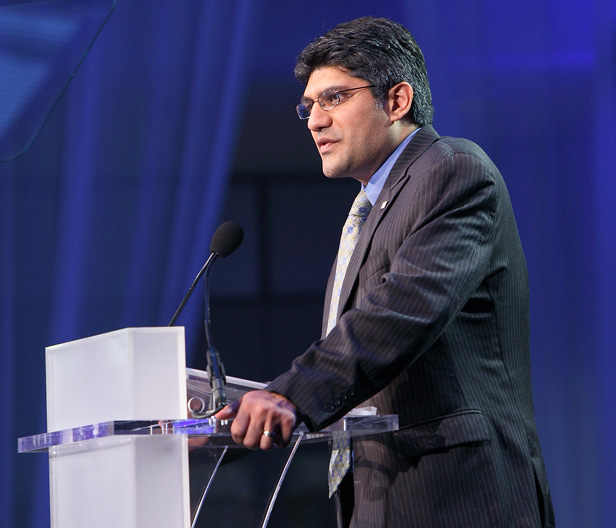New Fund Wants to Loosen One Clean-Tech Bottleneck

Jigar Shah pioneered a financing model that’s contributed to a recent boom in solar-panel installation. He’s now looking to do the same for other clean energy technologies.
In 2003, Shah founded SunEdison, a company that developed a way to build corporate and government solar installations by securing agreements to purchase the resulting electricity. It was acquired for $200 million in 2009. Now he’s becoming a partner in a new clean-tech fund, Inerjys, which is raising $1 billion to tackle what Shah views as the biggest obstacle to reducing carbon emissions and fossil fuel consumption. He argues that the choke point is not in developing new breakthrough technologies, as some investors believe. Rather, he says, it’s in finding “breakthrough deployment” models that would move technologies into widespread commercial use.
Canadian entrepreneur Stephan Ouaknine, who made his fortune in telecommunications startups, founded Inerjys to make strategic investments in clean tech. In some cases, the fund will seek traditional ownership stakes. But in most cases, Inerjys plans to follow a less common course. Without taking on or expanding its ownership stakes in clean-tech startups, it will finance specific projects, such as the construction of an offshore wind turbine, in exchange for a share of the revenue the project will ultimately generate.
“This vision completely aligns with what my experience has been,” says Shah. “SunEdison didn’t invent any technology. We just figured out how to deploy it.”
Similarly, Shah hopes the Inerjys model helps loosen sticking points for other clean energy technologies. Today, financial institutions such as Wells Fargo and BlackRock are backing what he calls “boring” solar and wind projects—almost 2,000 megawatts of solar power were installed in the U.S. last year, more than double 2010’s amount—but Shah says they won’t generally take risks on less-established concepts.
Rentricity, for example, is a nine-year-old startup with a valve technology that produces electricity by harnessing the pressure changes in water-main pipes. It has installed three systems so far and is now, for the first time, seeking outside financiers for help in deploying more. Rentricity founder Frank Zammataro says he is speaking with Inerjys and a few other firms that seem interested, but most others will only back much larger solar and wind projects. “Is there a hole in this market? There absolutely is,” he says.
Shah says the traditional venture capital model has forced the founders of clean-tech companies to relinquish too much equity in hopes of scaling up and commercializing their breakthroughs. He says that has been a bad situation for all involved: founders become less motivated as their ownership is reduced, and yet this model hasn’t given many companies enough capital to make significant progress.
At Inerjys, Shah wants to turn his attention to “underappreciated technologies” like Rentricity’s. In his most recent position as CEO of Richard Branson’s nonprofit climate-change initiative the Carbon War Room, he says, he unearthed hundreds of technologies in more than a dozen sectors that could return their initial investments within two years.
Another example Shah cites is Zinc Air, a Montana-based startup developing a grid-storage battery based on an established chemistry that could be profitable in some regions today. Zinc Air vice president Craig Wilkins says the company is avoiding federal government grants and loan guarantees and plans to market its technology to stand on its commercial merits. He’s optimistic as he seeks investment to build the first commercial projects, but he must overcome the poor reputation that clings to battery companies after previous failures. Like Zammataro at Rentricity, he says new financing models for the energy storage market, such as what Shah did for solar at SunEdison, would be a big innovation for him.
Rachel Sheinbein, a partner in energy and materials at the venture firm CMEA Capital, says Inerjys’s model seems interesting as a way to address one funding bottleneck in the industry. But she points out that raising money is still difficult at every stage of development, from early-stage venture capital on up—“even for companies that are doing everything right.”
Keep Reading
Most Popular
Large language models can do jaw-dropping things. But nobody knows exactly why.
And that's a problem. Figuring it out is one of the biggest scientific puzzles of our time and a crucial step towards controlling more powerful future models.
The problem with plug-in hybrids? Their drivers.
Plug-in hybrids are often sold as a transition to EVs, but new data from Europe shows we’re still underestimating the emissions they produce.
Google DeepMind’s new generative model makes Super Mario–like games from scratch
Genie learns how to control games by watching hours and hours of video. It could help train next-gen robots too.
How scientists traced a mysterious covid case back to six toilets
When wastewater surveillance turns into a hunt for a single infected individual, the ethics get tricky.
Stay connected
Get the latest updates from
MIT Technology Review
Discover special offers, top stories, upcoming events, and more.